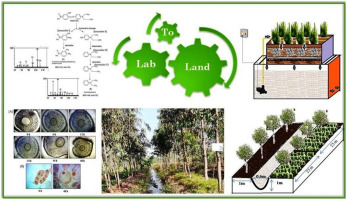Ecotoxicology and Environmental Safety ( IF 6.2 ) Pub Date : 2018-05-30 , DOI: 10.1016/j.ecoenv.2018.05.078 Anuprita D. Watharkar , Suhas K. Kadam , Rahul V. Khandare , Parag D. Kolekar , Byong-Hun Jeon , Jyoti P. Jadhav , Sanjay P. Govindwar

|
This study explores the potential of Asparagus densiflorus to treat disperse Rubin GFL (RGFL) dye and a real textile effluent in constructed vertical subsurface flow (VSbF) phytoreactor; its field cultivation for soil remediation offers a real green and economic way of environmental management. A. densiflorus decolorized RGFL (40 gm L−1) up to 91% within 48 h. VSbF phytoreactor successfully reduced American dye manufacture institute (ADMI), BOD, COD, Total Dissolved Solids (TDS) and Total Suspended Solids (TSS) of real textile effluent by 65%, 61%, 66%, 48% and 66%, respectively within 6 d. Oxidoreductive enzymes such as laccase (138%), lignin peroxidase (129%), riboflavin reductase (111%) were significantly expressed during RGFL degradation in A. densiflorus roots, while effluent transformation caused noteworthy induction of enzymes like, tyrosinase (205%), laccase (178%), veratryl oxidase (52%). Based on enzyme activities, UV–vis spectroscopy, FTIR and GC-MS results; RGFL was proposed to be transformed to 4-amino-3- methylphenyl (hydroxy) oxoammonium and N, N-diethyl aniline. Anatomical study of the advanced root tissue of A. densiflorus exhibited the progressive dye accumulation and removal during phytoremediation. HepG2 cell line and phytotoxicity study demonstrated reduced toxicity of biotransformed RGFL and treated effluent by A. densiflorus, respectively. On field remediation study revealed a noteworthy removal (67%) from polluted soil within 30 d.
中文翻译:

垂直地下流植物反应器中的芦笋浓密粉,用于处理真正的纺织品废水:通过实验室着陆的方法进行原位土壤修复
这项研究探索了芦笋在构建的垂直地下流(VSbF)植物反应器中处理分散的Rubin GFL(RGFL)染料和实际纺织废水的潜力;其用于土壤修复的田间耕作提供了一种真正的绿色和经济的环境管理方式。A. densiflorus使RGFL(40 gm L -1)脱色,在48小时内达到91%。VSbF植物反应器成功地将美国实际染料废水的美国染料制造协会(ADMI),生化需氧量(BOD),化学需氧量(COD),总溶解固体(TDS)和总悬浮固体(TSS)降低了65%,61%,66%,48%和66% 6 d内。RGFL降解过程中氧化还原酶如漆酶(138%),木质素过氧化物酶(129%),核黄素还原酶(111%)显着表达。A. densiflorus的根,而流出物的转化引起了诸如酪氨酸酶(205%),漆酶(178%),藜芦氧化酶(52%)等酶的显着诱导。基于酶活性,紫外可见光谱,FTIR和GC-MS结果;提出将RGFL转化为4-氨基-3-甲基苯基(羟基)氧铵和N,N-二乙基苯胺。的先进根组织的解剖学研究A. densiflorus表现出植物修复期间逐步积累染料和去除。HepG2细胞系和植物毒性研究分别证明了生物转化的RGFL的毒性降低和被A. densiflorus处理的废水降低了毒性。现场修复研究表明,在30天之内从受污染的土壤中有显着去除率(67%)。











































 京公网安备 11010802027423号
京公网安备 11010802027423号